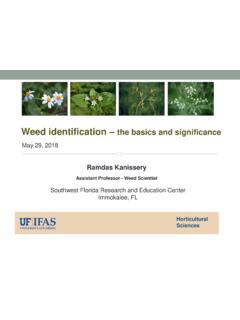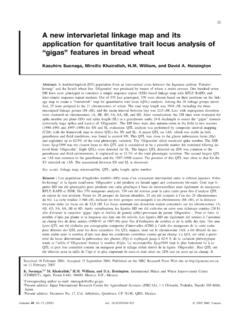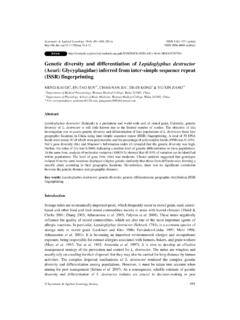Transcription of Species clarification of Isaria isolates used as ...
1 Species clarification ofIsariaisolates used asbiocontrol agents againstDiaphorina citri(Hemiptera: Liviidae) in MexicoAdrien GALLOU*, Mar a G. SERNA-DOM INGUEZ,Ang elica M. BERLANGA-PADILLA, Miguel A. AYALA-ZERME~NO,Marco A. MELL IN-ROSAS, Roberto MONTESINOS-MAT IAS,Hugo C. ARREDONDO-BERNALC entro Nacional de Referencia de Control Biol ogico, Km Carretera Tecom an-Estaci on FFCC, Col. Tepeyac, , Tecom an, Colima, Mexicoarticle infoArticle history:Received 12 August 2015 Received in revised form26 October 2015 Accepted 29 November 2015 Corresponding Editor:Kevin D. HydeKeywords:Biological controlEntomopathogenic fungiIsaria javanicaISSR markersMorphologyPhylogenyabstractEntomo pathogenic fungi belonging to the genusIsaria(Hypocreales: Cordycipitaceae) arepromising candidates for microbial control of insect pests.
2 Currently, the Mexican govern-ment is developing a biological control program based on extensive application ofIsariaisolates againstDiaphorina citri(Hemiptera: Liviidae), a vector of citrus huanglongbing dis-ease. Previous research identified three promisingIsariaisolates (CHE-CNRCB 303, 305, and307; tentatively identified asIsaria fumosorosea) from Mexico. The goal of this work was toobtain a complete morphological and molecular characterization of these isolates . Com-parative analysis of morphology established that the isolates showed similar characteris-tics toIsaria javanica. Multi-gene analysis confirmed the morphological identification byincluding the three isolates within theI. javanicaclade. Additionally, this work demon-strated the misidentifications of three otherIsariaisolates (CHE-CNRCB 310 and 324:I.)
3 Jav-anica, formerlyI. fumosorosea; CHE-CNRCB 393:I. fumosorosea, formerlyIsaria farinosa),underlying the need for a full and correct characterization of an isolate before developinga biological control program. Finally, the inter - simple sequence repeat (ISSR) genotypingmethod revealed that the CHE-CNRCB 303, 305, and 307 isolates belong to three differentgenotypes. This result indicates that ISSR markers could be used as a tool to monitor theirpresence in field conditions. 2015 The British Mycological Society. Published by Elsevier Ltd. All rights within the genusIsaria(Hypocreales:Cordycipitaceae) are entomopathogenic fungi (EPF) with a widespread globaldistribution (Gamset ). The catalogue of the USDA-ARS Collection of Entomopathogenic Fungal Cultures (ARSEF)contains more than 1000 Isariastrains from numerous coun-tries in North, Central, and South America, Europe, Africa,Australia, and Asia.
4 In addition,Isariastrains can infect differ-ent insect orders in all developmental stages, and are com-monly isolated from soil (D Alessandroet ).Originally,Isariawas considered a subsection within the*Corresponding author. Centro Nacional de Referencia de Control Biol ogico (Laboratorio de Biolog a Molecular), Km , CarreteraTecom an-Estaci on FFCC, Col. Tepeyac, 28110, Tecom an, Colima, Mexico. Tel.: 52 (31) 33 24 07 45; fax: 52 (31) 33 24 27 Gallou).journal biology xxx (2015) 1e10 2015 The British Mycological Society. Published by Elsevier Ltd. All rights cite this article in press as: Gallou A, et al., Species clarification ofIsariaisolates used as biocontrol agents againstDia-phorina citri(Hemiptera: Liviidae) in Mexico, Fungal Biology (2015), (1974), who divided this ge-nus into two sections: sectionPaecilomyces(thermophilic) andsectionIsarioidea(mesophilic).
5 However, this distinction wasbased on morphological characteristics that may be highlysubjective and lead to ambiguous identifications at the specieslevel. Formal conservation of the generic nameIsariawas offi-cially accepted in 2005 (Gamset ).Molecular phylogenetic studies have resurrected the genusIsaria(Luangsa-ardet ; Sunget ). The polyphy-letic nature of the genusPaecilomyces( , including the ) has been demonstrated several times previouslyby analyses of the large and small subunit rRNA genes(Oborniket ; Luangsa-ardet ). However, usingtheb-tubulin gene and the nuclear ribosomal internal tran-scribed spacer (ITS) region,Luangsa-ardet al.(2005)investi-gated the phylogenetic relationships , and established the existence of a monophy-letic group named Isariaclade , which includes: Isaria amoe-neroseaHenn.
6 , Isaria cateniannulata( Liang) Samson &Hywel-Jones, Isaria cateniobliqua( Liang) Samson &Hywel-Jones, Isaria cicadaeMiq., Isaria coleopterora(Samson & Evans) Samson & Hywel-Jones, Isaria farinosa(Holmsk.)Fr., Isaria fumosoroseaWize, Isaria ghanensis(Samson & H. ) Samson & Hywel-Jones, Isaria javanica(Friederichs &Bally) Samson & Hywel-Jones, andIsaria tenuipesPeck. Morerecently,Sunget al.(2007)used multilocus sequence typing(MLST) to construct a phylogeny of the clavicipitaceous fungi,distributing the genusPaecilomycesamong three families oftheHypocreales( ,Cordycipitaceae,Clavicipitaceae, andOphio-cordycipitaceae). Currently, some Species from this genuswere excluded from bothPaecilomycesandIsaria, or still awaittransfer into appropriate genera.
7 For instance,Luangsa-ardet al.(2011)showed thatPaecilomyces lilacinus, placed in theOphiocordycipitaceae, was not related toPaecilomycesand pro-posed the new genus Purpureocillium . In addition,Kepleret al.(2014)recently included in the definition of the genusMetarhiziumseveral Species previously placed inPaecilomyces[ ,Metarhizium carneum(Duch e & R. Heim) Kepler, Reh-ner & Humber formerlyPaecilomyces carneus(Duch e & R. Heim) Br. Metarhizium marquandii(Massee) Kepler, Rehner & Humber formerlyPaecilomyces marquandii(Mas-see) S. Hughes;Metarhizium viride(Segretain, Fromentin, Des-tombes, Brygoo & Dodin ex Samson) Kepler, Rehner &Humber formerlyPaecilomyces viridisSegretain, Fromentin,Destombes, Brygoo & Dodin].
8 Diaphorina citriKuwayama (Hemiptera: Liviidae), the Asiancitrus psyllid, is a worldwide citrus pest due to its role as a vec-tor of the phloem-limited bacteriaCandidatusLiberibacterspp., which causes citrus huanglongbing (HLB) (Halbert &Manjunath 2004). EPF could play an important role in the reg-ulation ofD. citripopulations and are promising microbial can-didates for control of phloem feeding pests (Hajek & St. Leger1994; Goettelet ).Meyeret al.(2008)reported the isola-tion and characterization of anI. fumosoroseastrain naturallyinfecting the psyllid in Florida, andStaudermanet al.(2012)confirmed their potential in the management ofD. is a megadiverse country that forms part of theMesoamerican biological corridor that connects North andSouth America, and is a source of natural enemies to contrib-ute to biological control programs (Williamset ).
9 The Servicio Nacional de Sanidad, Inocuidad y Calidad Agroali-mentaria (SENASICA), through the Direcci on General deSanidad Vegetal (DGSV) of the Mexican government, hasdesigned a program to develop technology for the biologicalcontrol ofD. citri. This program has selected threeIsariaiso-lates from Mexico, previously identified asI. fumosorosea( ,CHE-CNRCB 303, 305, and 307), for extensive applications inthe Regional Areas of Control of Asian citrus psyllid (Spanishacronym: ARCOS) (S anchezet ).Ram rez-Balboaet al.(2012)demonstrated the efficacy of these isolates in field con-dition againstD. citri( , mycosis between 66 and %). Fur-thermore, to obtain a more highly-virulent mycoinsecticide,the development of highly effective single-spore isolates isin progress (Ayala-Zerme~noet ).
10 For a biological control program to be successful, knowl-edge of the exact identities of the pest and biological controlagent Species is crucial. For this reason, the threeIsariaiso-lates were characterized morphologically asI. fumosoroseaprior to its consideration within a biological control , the change in status of the genusIsariapointed outthe need to use molecular methods (Luangsa-ardet ;Sunget ) to characterize the threeIsariaisolates. Like-wise,Cabanillaset al.(2013), using molecular techniques, de-termined that 12 out of 16 IsariaorPaecilomycesisolateslisted in the ARSEF or Centraalbureau voor Schimmelcul-tures (CBS; Utrecht, Netherlands) collections were misidenti-fications. Therefore, the purpose of this study was to obtaina complete morphological and molecular characterization oftheIsariaisolates ( , 303, 305, and 307) being used as biolog-ical control agents againstD.











